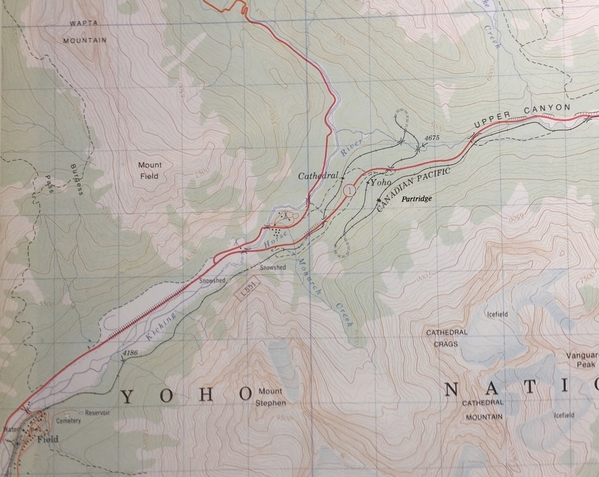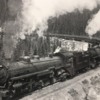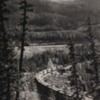3 crew members killed in CP train derailment near Field, B.C.
Replies sorted oldest to newest
Very sad news. It will be interesting to learn the cause, as determined upon completion of investigation.
Very tragic
Some Calgary news reporting train was going twice the speed restriction
Perhaps loss of brake pressure while decending the “Big Hill”
Al
Firewood posted:3 crew members killed in CP train derailment near Field, B.C.
The news photo shows a wrecked Union Pacific engine. I wonder what that is all about?
What a scene !
Very sad. One has gotta think it will take weeks to clean up. So sad.
GregR posted:Firewood posted:3 crew members killed in CP train derailment near Field, B.C.
The news photo shows a wrecked Union Pacific engine. I wonder what that is all about?
Run-through interchange power as I understand it. Railroads have been doing it for a few decades now - the accountants sort out the horsepower-hours later.
albertstrains posted:Very tragic
Some Calgary news reporting train was going twice the speed restriction
Perhaps loss of brake pressure while decending the “Big Hill”
Al
A horrible situation, Albert - starting to see unconfirmed reports of a runaway situation and a recent crew change. There will be some hard-to-hear stuff coming up I think.
Not uncommon to see UP NS units on CP lines around Calgary
For some reason there was a crew change at the top of the Hill, which is unusual as Field is the normal crew change point, located at the bottom of the Hill
Locomotives left the rails at what appears to be the Kicking Horse river bridge between the two spiral tunnels
Al
 Here is a map showing the area in question.
Here is a map showing the area in question.
The bridge(elevation 4675m) is where the units fell approx 300 feet into the Kicking Horse river. This is just westbound of Yoho
Grain cars are piled up on the ground before the #1 Highway overpass from the pics I have seen on the news
The grade is approximately 2.2%
Here are a couple vintage pics showing the bridge in question. There is a second bridge across the same river but it’s right after the lower entrance to the lower spiral tunnel
Al
Attachments
Correction, the elevation on the map of the bridge is in feet not metres
Reports say the locomotives fell 160m into the river but I don’t believe the bridge is that high at this location?
At any rate the “Big Hill”is still an incredibly dangerous stretch of mainline to this day and I have nothing but respect for the Railroaders who have worked it
The 3 crew members were from Calgary
Praying for the Families of the crew
Al
Mountain grade railroading is always dicey. On most trips it's uneventful, but, when one little thing goes wrong, you can have coupler failures and derailments going upgrade, or a runaway going downgrade. Going downgrade, you're always about one minute away from having a runaway, if speed unexpectedly begins to increase. Weird things can happen. This train obviously got away from the crew, and, from the look of the terrain, there may not have been a good place to jump off. May God grant them eternal rest.
A Railway Age article with more info about operating practices for that segment of railroad:
---PCJ
More from Railway Age, with a prelimiary report from the Canadian Transportation Safety Board, and corrections to the map in the previous link showing the location and diagram of the derailment site.
A couple of eyebrow-raising quotes :
--The train had been stopped with the air brakes applied in emergency at Partridge, the last station prior to the entrance to the Upper Spiral Tunnel. (the train had been stopped this way for two hours--on the grade)
--A change-off between crews had occurred at this location as the previous crew were closing in on their maximum hours of service.
--There were no hand brakes applied on the train. The train then accelerated to a speed well in excess of maximum track speed of 20 mph for the tight curves and steep mountain grade. and the(n) derailed.
There is more in the link--I didn't quote the entire article.
---PCJ
RailRide posted:More from Railway Age, with a prelimiary report from the Canadian Transportation Safety Board, . . .
A couple of eyebrow-raising quotes :
--The train had been stopped with the air brakes applied in emergency at Partridge, the last station prior to the entrance to the Upper Spiral Tunnel. (the train had been stopped this way for two hours--on the grade)--There were no hand brakes applied on the train. The train then accelerated to a speed well in excess of maximum track speed of 20 mph for the tight curves and steep mountain grade. . .
---PCJ
I have highlighted the key information discovered thus far. Focus on that and follow the investigation into
- why the first crew stopped in emergency
- why they did not apply any hand brakes, to safeguard against the possibility of air pressure leaking down, or against an unintended release of all air brakes, when it became apparent that the train would be sitting on a 2% descending grade for an extended period
- why the second crew did not apply hand brakes sufficient to hold the train at rest while they recharged the brake pipe from the emergency brake application made by the first crew
- what caused the train to begin to move on its own after the second crew boarded the train (i.e., leakage? or unintended release?) and how much time elapsed between the time the second crew boarded the train and it began to move on its own
- Why the second crew remained aboard the train after it began to move on its own, instead of stepping or jumping off
- whether or not the Engineer mis-handled what remaining air brake capability he had available, after proceeding
- the actual amount of mountain grade, heavy train, experience of every crew member on both crews. (Their years of experience do not tell whether most of it was spent in yard or local freight service, or whether it was on a non-mountainous territory)
- whether CP has had in place a program of randomly reviewing, by a competent reviewer, event recorder data from several trains each week which were operated eastward as well as westward, over this territory, and including each regularly assigned Engineer at least once quarterly
- whether CP has had in place a program to review and analyze the event recorder data from every train which stopped from a heavy or an emergency brake application on any main track, and especially on mountain grades
The findings on these yet-unpublished queries will be the path to determining the contributing cause(s). From the information that has so far been released, the root cause has already been found: failure to secure the train with hand brakes to prevent movement of the train before the air brake system had been recharged, on a 2% descending grade. But why? That is the question. Nobody on the second crew remains alive to testify, so -- in addition to the first crew -- investigation into CP's process for monitoring the compliance of its crews may tell us whether improper practices were or were not commonly engaged in.
Tom,
I'm no air brake "expert" by any means, but one thing I do remember; when the brake valve is place in the emergency position, the Pressure Maintaining feature is disabled. Thus, why in the world would the pervious crew have placed the train in emergency, approximately 2 hours prior to the replacement crew's arrival? Without any pressure maintaining, sooner or later, the brakes will release, and with no hand brakes applied,,,,,,,,,,,away goes the train on the down grade!
The subsequent investigation and interviews of personnel involved it this disaster will surely be very interesting.
That's a good question, "why did the previous crew put the train into emergency rather than a full brake application?
I'm assuming the dynamic brakes could not hold the train and as soon as the air was recovered the brakes released, with not enough time to fully charge the train line and the train moved out on it's own.
However a train left in emergency should not Bleed off in a few hours. There must be something else going on..
Question ....what happens to DPU units inside a tunnel? Do they stop loading, What happens to the dynamic brake on these units with loss of radio communications.
Oh my. This one is going to be involved. I agree with Tom and Hot:
* The previous crew did not properly secure the train.
* The replacing crew did not properly secure the train and properly charge the brake line before proceeding downgrade.
Having railroaded routinely on 2.69% grades, often times with nothing but air (no dynamics), and this includes having to double the grade, etc, such grades are very demanding and you simply cannot run the risk of not having your head cut-in at all times. Make one "small" mental mistake (or series of small mistakes) can lead to disaster, such as this.
I would often run passenger turns to the summit town, run around, re-couple, and head back down the grade for the return trip. I ALWAYS gave adequate time for my brake system to recover from the run-around move BEFORE I started down the mountain. I also EXPLAINED IN DETAIL what I was doing to new Conductors (that didn't understand why I didn't whistle off and get on with the show) as well as any new Engineer/Conductors I had with me. Steep grades are serious business.
Andre
Gregg posted:That's a good question, "why did the previous crew put the train into emergency rather than a full brake application?
I'm assuming the dynamic brakes could not hold the train and as soon as the air was recovered the brakes released, with not enough time to fully charge the train line and the train moved out on it's own.
Reportedly, the new out-bound crew had not yet attempted to "recover the air brakes", as the train moved out on its own.
However a train left in emergency should not Bleed off in a few hours. There must be something else going on..
Maybe the outside temperature being below zero degrees F may have had something to do with it.
Question ....what happens to DPU units inside a tunnel?
Generally, nothing as there are "repeaters" for the radio signals inside the tunnels.
Do they stop loading,
No.
What happens to the dynamic brake on these units with loss of radio communications.
As stated above, there is normally no loss of radio communications for the DPU. However, if there is a "loss of radio signal", the DPUs are usually programed to operate at their last received radio communication, or until brake pipe pressure is reduced, then they drop to idle (when in DP, they may continue to provide braking effort).
The preliminary report also said: "Sixteen cars of a CP train derailed on Jan. 3 in the same area. No one was hurt in that derailment."
I took the Rocky Mountaineer through this area about six years ago. The Mountaineer passed about 10 wrecked freight cars alongside the track near the upper tunnel. It is obvious that this is a dangerous grade that requires special attention and train handling from crews to prevent accidents. It will be interesting to learn what CP's procedures/rules are for trains in this area and if they are being followed.
Of course, the other explanation may be that there was a catastrophic equipment failure that no crew could have overcome. It appears that the UP locomotive was leading. Do UP and CP locomotives have the exact same controls in the same location? Could a difference in control and or control location affect train handling? I know that whenever I rent a car I need to locate the headlight and windshield wiper switches before I leave the parking lot. I had a scary experience in a rental car many years ago when I got into a sudden rain shower and I couldn't find the wiper switch for several seconds. I was driving blind for what seemed like forever. NH Joe







